
43 minute read
Syd Shores: A Daughter Remembers
SYD SHORES: A Daughter Remembers An Interview With NANCY SHORES KARLEBACH Conducted & Transcribed by Richard J. Arndt
Syd Shores A studio-portrait photo of the artist as a middle-aged man. Courtesy of Nancy Shores Karlebach and Shaun Clancy.


From Golden Age To Red Wolf Syd Shores’ dramatic cover for Captain America Comics #21 (Dec. 1942)—and one of his last covers for Marvel Comics: Red Wolf #6 (March 1973). John Romita reportedly did a touch-up or two on the latter. Thanks to the Grand Comics Database. [TM & © Marvel Characters, Inc.] Nancy Shores Karlebach & Stan Goldberg at a New York comics convention in October 2010. Nancy Shores was born in 1948. Stan G. colored many of Shores’ covers in the ’40s and ’50s; sadly, the beloved colorist and “Millie the Model”/”Archie” artist passed on in 2014. Photo courtesy of Dr. Michael J. Vassallo.

An Interview With Nancy Shores Karlebach I NTERVIEWER’S INTRODUCTION: Syd Shores was born in 1913 and passed away on June 3, 1973. He began his career in comics as an art assistant for Mac Raboy while working in the shop run by Harry “A” Chesler. While there, he was also partnered with fellow artist Phil Sturm. He soon became an inker on Joe Simon & Jack Kirby’s Captain America Comics. When they left Timely Comics for National (DC) Comics, Shores was one of the artists chosen to replace them on “Captain America” stories. He soon also became Timely’s unofficial art director. After an interruption in his career for military service in World War II, he returned to draw Captain America. He also co-created and drew “The Blonde Phantom.” After Martin Goodman directed Stan Lee to fire the Timely bullpen staff in 1949, Shores also did work for comics publishers Avon and Orbit Publications, perhaps also for Lev Gleason’s Crime Does Not Pay. During the late 1940s and early ’50s, Shores moved from super-hero comics to Western, war, and jungle comics. When assignments in the field dried up from the effects of the Comics Code and Atlas’ distributor woes, he moved into illustrating men’s-adventure magazines for about eight years. In 1967 he returned to Goodman’s comics line, now called Marvel Comics, as an inker on Gene Colan’s Daredevil and Jack Kirby’s Captain America, among other titles. He also worked on Marvel’s war and mystery comics, as well as drawing non-Code horror stories for Warren, Skywald, and Major’s black-&-white magazine titles. When Marvel began publishing its own b&w horror magazines in the early 1970s, Shores was clearly poised to become a major part of that line. However, his work there was interrupted by a fatal heart attack at the age of 59. This interview took place on July 12, 2018.
RICHARD ARNDT: We’re welcoming Nancy Shores Karlebach, Syd Shores’ daughter, to talk about her dad. Thanks for agreeing to this interview, Nancy. What can you tell us about him?
NANCY SHORES KARLEBACH: His full name when he was born was Sidney Lawrence Schwartz. He changed it when he became an artist.
RA: Was that change the same reason that so many other Jewish writers and artists changed their names? To have a name that sounded less ethnic? KARLEBACH: That could have been, but I think he just wanted a name with a little more of a ring to it. Schwartz was a common name in the area he grew up in, but an awful lot of people, not just Jewish people but immigrants in general, wanted an Americansounding name and changed their names or the spellings of their name to achieve that. And in comics, a lot of that was happening— Jack Kirby, Stan Lee, Gil Kane—these men and a lot of others changed their names. I can’t say for certain why he changed it, but I know that he wanted it to stand out.
RA: Sure, if you’re going to pick a new name for business reasons, you’d want to pick one that stands out. That makes perfect sense. Do you know where he got his education, particularly his art education? KARLEBACH: Dad went to Pratt.
RA: That would be the Pratt Institute in Brooklyn? KARLEBACH: That would be correct. The Pratt Institute of Fine & Applied Art. He went to night classes there and graduated. He attended classes there for some time, perhaps as long as seven years before finishing up his coursework and receiving his certificate.
He also had an art display at the Brooklyn Museum when he was a teenager. He had won an art contest and that was the prize. He also won an art contest sponsored by a dog food company, that may have been the first publication of any of his art. He drew a poster dealing with the mistreatment of puppies. away before I was even married. For years I’ve been thinking of writing up a whole book of stories about him and his life. I didn’t really follow his work when I was a kid because he was just my dad. [laughs] I knew what he did and so on, but I never followed the details of comics. In fact, my father discouraged my sister and I from reading comics because he felt books were better for our education, The Shores Of Tripoli? (Or Maybe France?) not because comics Although he may have contributed inking and were bad but perhaps even some penciling to previous Captain because we were America Comics covers, this is the first one that is girls and I guess he didn’t think definitively his: for issue #20 (Sept. 1942). [TM & © Marvel Characters, Inc.] there were many prospects for girls reading comics.

So I thought I would write about his life for my children. Then I thought that, if it sounded OK, maybe it could be turned into a book, because a lot of artists have had books written about them in the last few years. So that’s on my to-do list. That why I’ve put material together in a folder.
RA: That’s not a bad idea. Now, I know that before he entered comics he worked for his uncle in a whiskey-bottling place. KARLEBACH: Yes, that’s correct. I don’t know the exact name of that business, however. When he entered into comics, he was working for my mother, Selma’s ...well, she was his wife-to-be at the time... cousin, Phil Sturm. It was with Phil that he worked on his own debut story, “Introducing The Terror,” which appeared in Timely’s Mystic Comics #5 [cover-dated Mar. 1941]. I don’t know if “The Terror” became a regular feature or not. I think that Phil wrote the story and my father did the artwork. [INTERVIEWER’S NOTE: George Klein is credited with inking that story.]
I always have a little hesitation when talking about this sort of thing, because I feel I should know all this stuff, but this happened, of course, before I was born.
My father was the third person hired on staff for Timely. Joe Simon was his editor. This was working for Simon and Kirby, under Martin Goodman. My father was working as an inker on Captain America fairly early on. First over Kirby’s pencils in All Winners Comics #1 [Summer 1941], and then on the cover of the regular Captain America title, starting in #5 [Aug. 1941].
RA: He continued on Captain America for quite some time after that point, as I recall.
Syd & Selma Shores (at right) have a night out in 1965. Syd’s first comics story, “The Terror” in Timely’s Mystic Comics #5 (March 1941), was written by his future wife’s cousin, Phil Sturm—as was “Mr. Liberty” in U.S.A. Comics #1 (Aug. ’41). Interviewer Richard Arndt tells us that George Klein inked the first effort. Thanks to Nancy Karlebach & Dr. Michael J. Vassallo for the photo, and to Doc V for the art scans. [TM & © Marvel Characters, Inc.]

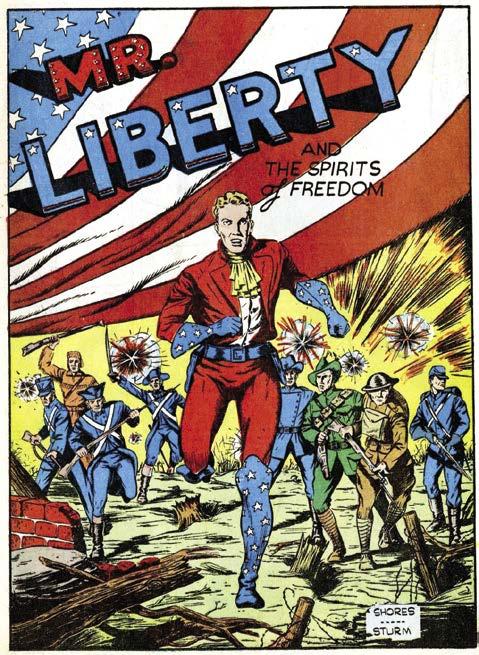
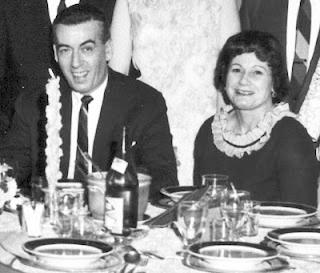
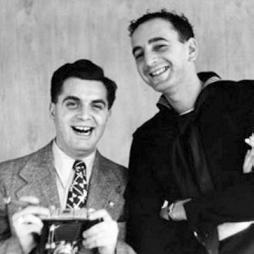
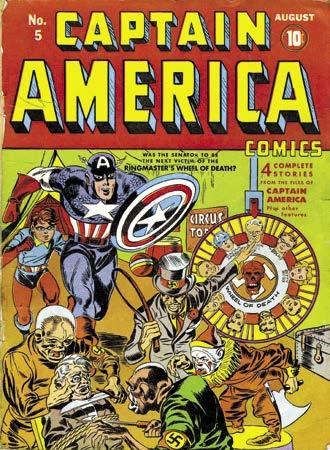
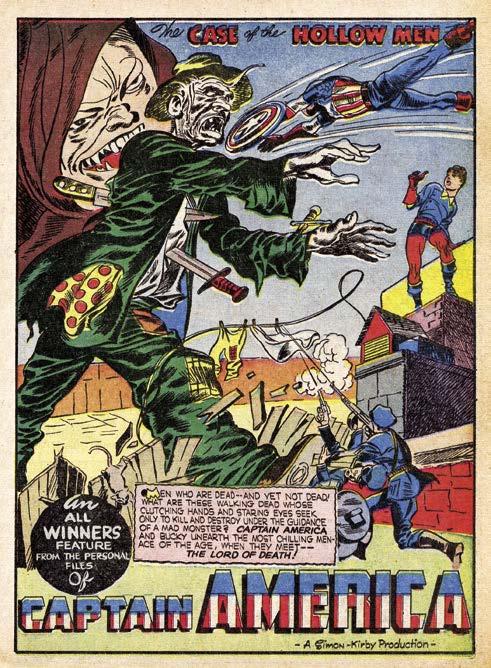
Jack Kirby & Joe Simon (left to right in above photo), during their World War II days—Jack was in the infantry, Joe in the Coast Guard. Nancy says her father told her he’d done at least some inking on the Simon & Kirby “Captain America” story in All-Winners Comics #1 (Summer 1941), and on their cover for Captain America Comics #5 (Aug. ’41). Thanks to Jim Kealy and Dr. Michael J. Vassallo for the art scans, and to Mike Mikulovsky for finding the photo on the Internet. [Pages TM & © Marvel Characters, Inc.]
KARLEBACH: Yes, he did. It was only a short time later that both Jack Kirby and Joe Simon left the book and my father, along with an artist named Al Avison, drew or inked Captain America for most of the rest of the 1940s. I know that I met Al Avison when I was in my early twenties, but I didn’t really know him at all. I used to go to the comicbook conventions with my father when they first started—the ones that Phil Seuling ran [in New York City]—and my father would get his sticker and wander the convention. It was basically one big room, not like it is today. I did meet a number of the artists at that time, but I didn’t really know them.
RA: Did you know Vince Alascia?


KARLEBACH: He inked a lot of the “Captain America” stories of the 1940s, and I did meet him. I have a good recollection of what he looked like, but again, I didn’t really know him. A person you should perhaps talk to about specific artists who may have worked with my father is Michael Vassallo. [NOTE: No sooner said than done. See pp. 27-40 in this issue.] Do you know him? He’s actually a Vince Alascia dentist by trade, but he knows a great deal is seen here in a detail about comicbook artists and is something of the authority on Marvel Comics. from the famous 1942 “Bambi” photo (see other issues for details on I came to know Michael by way of Allen Bellman, who worked alongside my father early on at Timely, including work together the detail!)—and a Syd Shores-penciled splash page that Alascia inked for Captain America on Captain America. Allen is still alive. He Comics #40 (July 1944). was 93 at his last birthday, I think. [NOTE: Thanks to Jim Kealy for Sadly, Allen passed away on March 9, 2020, at the art scan. [TM & © the age of 95… after writing his memories of Syd Marvel Characters, Inc.] Shores for this issue.] He still goes to all the comic cons. Allen introduced me to Michael Vassallo, who lives in the Mitz siege and the Battle of the Bulge.] Then they flew him to England to recover and he was there for several New York, and he’s been very nice in getting information about my father. Michael is a collector and seems to know practically everything about everything comics-related. Anyway, you should talk to both of those gentlemen. KARLEBACH: I believe he worked for the rest of the ’40s on that title. At least until it was canceled. He was still the art director as well, although I don’t know if he ever actually had that title. I think his official title was associate editor. He also drew “The Blonde RA: Your dad was in the army during World War II. Do you know Phantom” in her comic series. That was my Dad’s. He created her. anything about his service? Well, he created her along with Stan Lee or whoever KARLEBACH: He was in the service for two years. He was wrote that first story. wounded December 16, 1944, and received the Purple Heart. He [NOTE: For the record, gave an interview once where he mentioned he was in the same the creator of The Blonde division or regiment as Jack Kirby but that they never actually met Phantom is in dispute. It each other at that time. I knew he was an admirer of Kirby’s work was either Stan Lee with and collected it. Syd Shores, or it was Al Sulman, who claims to
I’m looking through my papers and—here it is. He was in the have created her when he Third Army. was the script editor at RA: That would have been General Patton’s command, which Kirby was Timely. She debuted in also in, so that lines up. By the date of his wounding, I would guess that he All Select Comics #11 was wounded in the initial hours of the Battle of the Bulge. (Fall 1946), a title which KARLEBACH: I know he was wounded near Mitz, France. [NOTE: Phantom Comics with There was also a long siege of Mitz, which had ended only a few days #12 and ran for another before Syd was wounded, so there may be some sort of overlap between ten issues through 1949. transformed into Blonde months. You’re In The Army Now! And Syd Shores was, just in time for the RA: Following his World War II service, he returned to Battle of the Bulge a week or two before Marvel, or Timely, as it was still known at that point. He Christmas of 1944. Thank the heavens he worked again on Captain America. survived his war wound—and even got a Purple Heart! Thanks to Nancy Karlebach.
Stan Lee, Syd Shores, and inker Charles Nicholas are listed as the creative team on her first story in All Select.] I know that Dad did the costume design for The Blonde Phantom.
He also drew a lot of Westerns. That was sort of his specialty. He drew a lot of horses! [laughs] A lot of artists had a hard time with horses, but Dad could draw every little muscle.

RA: After Captain America and Blonde Phantom Comics were canceled, Timely gradually started being referred to as Atlas, which was actually Timely’s self-owned distribution company; since all their covers sported an Atlas “bullet” on them with no mention of Timely, the company started to be referred to as Atlas. The name just stuck, and continued even after the distribution wing was shut down. KARLEBACH: Is that how that happened? I never knew that. Didn’t they also use “Marvel” in the 1940s?
RA: They used the word “Marvel” as part of various comicbook titles, and even briefly at times as a company logo; but the line didn’t actually become “Marvel Comics” until 1961, when the first issue of Fantastic Four went on sale. Even then, it was actually identified as “MC” on the cover for over two years before they actually featured “Marvel Comics” on their covers. Same basic company all along, though.

Back Home Syd Shores’ first post-WWII cover for Captain America Comics was #59 (Nov. 1946), whose cover art graces this issue of Alter Ego—and certainly Timely/ Marvel and Stan Lee welcomed him back with open arms! The inside front cover of CA #59 listed him as “Art Associate.” He inked the second and third “C.A.” yarns in the issue—but apparently had nothing to do with the cover story’s interiors. Thanks to Dr. Michael J. Vassallo, Jim Ludwig, & Jim Kealy for the scans. [TM & © Marvel Characters, Inc.]
Your dad also worked for Avon and Orbit drawing comics. Do you know about those companies? KARLEBACH: No, I don’t know those. I know he drew the Two-Gun Kid.


RA: Since he drew the very first stories of that character, he may also have been the co-creator there as well. This would have been the first Two-Gun Kid, the Atlas version. There was a second, masked one, using the same name, who was the Marvel Comics version. Syd was also drawing a lot of war stories, which was a huge part of the Atlas line from 1952-1957. I think, at one point, they had over two dozen war comics running.
Blondes & Buckin’ Broncos Shores’ covers for Blonde Phantom #12 (Winter 1947)— actually the first issue, though Blondie got her start in the previous issue, when the mag was called All-Select Comics #11—and for All-Western Winners #3 (Winter 1948). Thanks to the GCD. [TM & © Marvel Characters, Inc.]
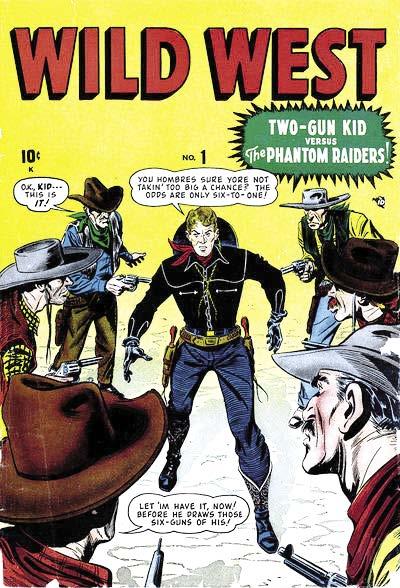
I know that Jack Kirby influenced your father’s art style quite a lot, because in the few interviews your dad did have, he mentioned that frequently. However, your dad was also one of the better draftsmen in his own right working in comics for that time period. KARLEBACH: Well, from what I’ve heard and read online, my father himself influenced a number of artists that came after him. He was actually considered the art director at Timely Comics, without having that exact title. He worked steadily at Timely from his debut there That’s One For Each Hand, Right? The original Two-Gun Kid was drawn by Syd on the cover of Wild West #1 (Spring 1948), among other places. in 1941 until he entered the service in 1944. After he was wounded, he spent four months in the hospital in Great Britain, then returned
Thanks to the GCD. [TM & © Marvel to active service until late Characters, Inc.] 1945 or early 1946. After that he worked at Timely again, in his old position until everyone was fired in 1948.
RA: Yes, I’ve heard before, from both Stan Goldberg and Russ Heath, that Martin Goodman would periodically have Stan Lee fire practically everyone in the bullpen, except Lee himself, when comics entered a downturn, and then Stan would gradually build the bullpen back up until Goodman would order him to fire everyone again. This apparently went on fairly regularly from 1949 until 1957, after which the regular bullpen was often just Stan Lee and his secretary for a number of years. Everybody else would have been working freelance. KARLEBACH: My Dad was there from nearly the very beginning and, being the unofficial art director, a lot of the artists who came into the bullpen during those years learned a great deal of their craft from my father.
RA: Gene Colan, in particular, had some very nice things to say about Syd in various interviews.
In the early 1950s, your dad had a studio setup with two other artists, Mort Lawrence and Norman Steinberg. Both of them also worked for Atlas during this period. Do you know why they joined together to set up a studio? KARLEBACH: In the late 1940s, those artists were all part of the bullpen. Then, in 1948, they were all fired and became freelancers, but were still working for Timely, or Atlas, or whatever name the company was using. I think that the three of them got together to form a studio, so that they could still work together, maybe help each other out when For companionship and a helping hand, as much as a business concern. I’m not “For A Golden Girl Knows When He’s Kissed Her…” To accompany the above line from the theme song of the 1964 film Goldfinger, here’s a Captain America cover Syd Shores executed not long before Martin Goodman laid off the entire Timely art staff, turning them into freelancers with no guaranteed weekly paychecks. Out front on issue #66 (April 1948), Bucky is badly wounded by a masked “Golden Girl” who will soon, as a heroine, replace the boy sidekick, in an attempt to goose the comic’s slumping sales. [TM & © Marvel Characters, Inc.]

positive on that. I was born that same year of the firings, in 1948, so I was only a child when that studio was running. Also, working in the city, close to where the publishers were at, meant that they could deliver pages closer to the deadline. Not have to commute, just walk a block or two.
Dad also worked, in his later years, in a studio with Wally Wood. There were other people there as well. It wasn’t just the two of them. I don’t know the names of the other artists, though. The studio was in Valley Stream.
Part of the reason for the studios was, it was just nice to get out of the house. Be with other people with the same interests and were
deadlines were tight... that sort of thing. doing the exact same thing as my Dad was—drawing.
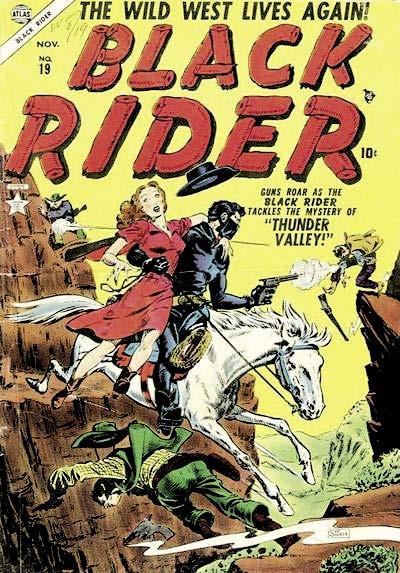


All A-Shore(s) In The Nifty ’50s! Among the many covers Shore drew in the first half or so of the 1950s—all of them reportedly colored by Stan Goldberg—are those of Battle Action #11 (April 1953), Black Rider #19 (Nov. ’53), and Annie Oakley #8 (Dec. ’55). Only the latter of these was not probably also inked by Syd—but its embellisher is unidentified. Thanks to Dr. Michael J. Vassallo and the Grand Comics Database, respectively. [TM & © Marvel Characters, Inc.]
RA: Your dad wouldn’t have been alone in wanting some company while drawing.
After the Atlas implosion of 1957, he left comics and did the interior art, as well as painted covers, for men’s-adventure magazines. Those magazines are totally gone now, but they lasted into the early 1970s. They were the type of heavily illustrated magazines that featured women who either wore very little or where the little that they wore was quite tattered, from battling Nazi and Japanese soldiers, often in gory detail. KARLEBACH: Yes, I actually have some of those magazines. You see, I was growing up in the late 1950s-early 1960s, which is when I became more aware of what Dad did. During that time, he wasn’t actually drawing comics. After things fell apart in comics, after Fredric Wertham and the coming of the Comics Code, he left comics because he wasn’t getting enough work. That’s when he began doing the art for those men’sadventure magazines.

RA: Martin Goodman, the publisher of Marvel Comics from the 1940s until 1969 or so, actually published a number of those magazines. Perhaps that connection was where Syd got his start doing those magazines. He certainly did do work for the Goodman-published men’s magazines, including All-Man, Escape to Adventure, and Man’s Prime. The Goodman magazines apparently reused covers quite a lot. KARLEBACH: I don’t think I knew that Martin Goodman had anything to do with those types of magazines, But, reusing the covers, [laughs] that sounds right! There were quite a number of those magazines at one time, published by a lot of different companies. I do have a portfolio of some of the originals, not a lot, mind you, of some of those covers and inside splashes. It’s not work that I would frame and hang up around the house, though! [laughs] Just for the subject matter.
Dad would have models come sometimes when he’d work on those magazines. At times, though, he would use my next door neighbor or my sister. Sometimes I can see the resemblance! [chuckles] Sometimes he used himself as well. Dad would set up the whole studio downstairs with the lights and props so that he could photograph the poses and the folds of fabric and things like that. He used to go to the public library and look for photos of uniforms and the like. He wanted to do them correctly.
RA: One of the things I think should be noted about your dad is that, along with Bill Everett and Russ Heath, he was one of the most accomplished artists working on the Timely/Atlas books. In addition, both Bill Everett and your dad were also very good inkers of other artists’ pencils.
The Many Artistic Worlds Of Syd Shores Likewise part of Syd’s pre-Implosion 1950s Timely output were the cover of Adventures into Terror #30 (April 1954)—a “Battle Brady” story (probably a reprint) that was turned by other hands into a 3-D story and plopped into that same year’s 3-D Action #1—and the final issue of Black Knight (#5, April 1956), as inked by Christopher Rule. Scripters unknown. Thanks to the GCD, Rod Beck, and Dr. Michael J. Vassallo, respectively. [TM & © Marvel Characters, Inc.]
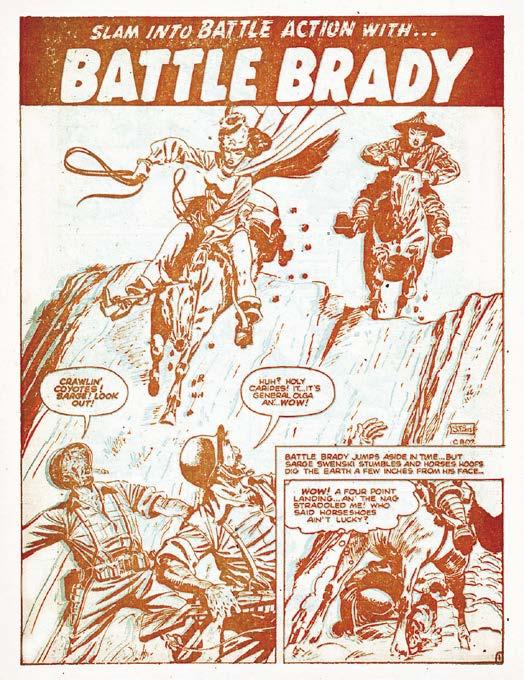

KARLEBACH: I know that Dad thought a lot of Bill Everett. I think that they died the same year. At the comic-con that year—you know they give out a convention book every year, and the book, as I remember, had tributes for both of them.
When comics got big again in the mid-1960s, Dad didn’t come back right away. I think that he preferred comics, but was a little distrustful that he could get all the work he needed to make a living. Finally, however, he came back. He inked Gene Colan on Daredevil and Jack Kirby on Captain America. He was also inking, and maybe penciling, a war book—Captain Savage?

RA: Yes, Captain Savage and His Leatherneck Raiders. He inked both Dick Ayers and Don Heck on that title. KARLEBACH: It’s ironic, in a way. Gene Colan was one of the artists that my Dad trained when he was the art director at Timely in the 1940s. Gene wrote a beautiful tribute about my Dad that’s appeared online. My father died in 1973 and my mother died
Adventures—The Kind Real Men Like! The Shores illustrations on this page were probably done in the late 1950s or early ’60s, when he was drawing interior art for various “men’s-adventure” magazines; the one with the marooned man and woman appeared in World of Men for Nov. ’66, a non-Martin Goodman title. The sources of the other two are unknown. Courtesy of Nancy K. [© the respective copyright holders.]
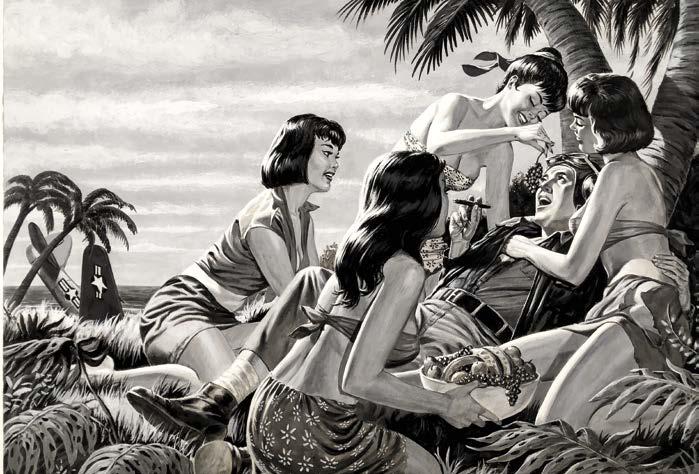


Martin Goodman in 1941. Thanks to Drew Friedman. He published a number of “men’s-adventure” magazines, but apparently none of them contained Shores artwork.


Splashing Ink Kirby & Shores, together again in the pages of Captain America #101 (May 1968)—and Colan & Shores, united in this splash from Daredevil #74 (March ’71). Scripts by Stan Lee and Gerry Conway, respectively. Thanks to Barry Pearl for the scans. [TM & © Marvel Characters, Inc.]
about 3½ years after that. My connection to all the people I’d met through my father was really gone by that time. Mother probably kept up with some of the people, but when you’re young, if you don’t see them every day, you just lose track. I wish that hadn’t happened. Even when Google—the Internet— came out, it didn’t really occur to me to search his name. Stan Lee Then one day I was, of course, the guy who assigned Syd typed in his name, and to ink Kirby, Colan, and others during the I couldn’t believe all Marvel Age of Comics. This photo probably dates from the late 1960s, around the time Shores came back to work for Marvel. the references to him. [giggles] All kinds of information! It was at that time that I found the online tribute from Gene Colan. That was interesting, reading about their early history, which I knew nothing about, and then about his later work, inking Gene.

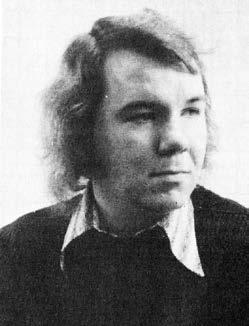

Gerry Conway & Gene Colan (left to right) from various sources.
You know, when I was young, I didn’t read comics all that much. I remember Archie—those kinds of comics, but most of the work that Dad did was for boys. Dad didn’t encourage us girls to read comics. He much preferred that we read books. That’s why I know so little about the comicbooks and have to do the research on them.
When I was a child, at a certain age, children were really discouraged from reading comics but, nowadays, educators realize that they’re really a great way to learn how to read.
RA: I found a note here, sitting underneath other research material, that says it took four years for, I guess Stan Lee, to convince Syd Shores to come back to comics. That Stan Lee had asked him the first time to come back in 1963.
KARLEBACH: Well, that makes sense, since he came back in 1967.

RA: Your dad also did a number of Marvel’s mystery tales, including an adaptation of a Harlan Ellison story [“Delusion for a Dragon Slayer”’ in Chamber of Chills #1 (Nov. 1972)]. He was also drawing stories for the Warren black-&-white books, as well as stories for Major’s Web of Horror and the Skywald black-&-white and color titles. In fact, the very first interview that I ever did was with Al Hewetson, the second editor of the Skywald books, just a few weeks before Hewetson himself died, and one of the things he was anxious to get into the interview was the story of his friendship with your dad. Al had worked a little while at Marvel, and his first published story was illustrated by your dad. He told me that before he became editor of the Skywald magazines, but while he was working as a writer for them, Syd had agreed to do horror stories for the company. The story he penciled actually appeared in one of Al’s first edited magazines, but Syd was very angry about the inking (by Dan Adkins) on the story, describing it to Al as a “vindictive ink job,” and refused to work for Skywald any longer. Al told me that he worked for two years to get Syd to agree to doing more work for Skywald and that Syd finally agreed to do more stories. However, before he could do any stories for them, he passed away. Al mentioned his sorrow in not having his friend work for him, and then Syd’s death, just when it looked like


The Magical Mystery Tour (Above left:) The first page of the Shores-drawn adaptation of science-fiction author Harlan Ellison’s short story “Delusion for a Dragon Slayer” from Chamber of Chills #1 (Nov. 1972), one of Marvel’s late four-color entries into the “mystery/horror” sweepstakes. On the following page, the nebbish hero wakes up in a Conanesque body and situation. Script by Gerry Conway. [Art © Marvel Characters, Inc.; original story © Estate of Harlan Ellison.] (Above right:) Terry Bisson scripted this Shores-illustrated tale for Major Magazines’ Web of Horror #1 (Dec. 1969) during the brief time it was going head to head with James Warren’s Creepy, Eerie, and Vampirella. [© the respective copyright holders.] Satan’s Inkwell? (Above:) As Richard Arndt relates on this page, Syd evidently hated Dan Adkins’ inking of the story “Satan’s Graveyard” from Skywald’s Nightmare #8 (Aug. 1972) so much that he not only insisted his credit be changed to the pseudonymous “Jim Elder” but also refused to do any further work for Skywald. Not to quarrel with Syd’s judgment, but does it really look all that terrible? Script by Al Hewetson. Thanks to Jim Ludwig. (Center of page:) Still, that didn’t stop Nightmare #13 (June ’73) from running this enhanced photo of Syd, long before he passed away. Courtesy of Jim Kealy. [Both images TM & © the respective trademark & copyright holders.]

that was going to turn around, was going to work out, was a great blow to Al.
KARLEBACH: I think that I knew Al Hewetson. I believe he was from Canada but he came to New York. I remember he once stayed at our house while he and Dad were working together on something. Maybe it was that story for Marvel that you mentioned.
Al Hewetson Conceptualizer of Skywald’s later “HorrorMood”—and, earlier, collaborator with Syd Shores on a projected magazine or comic strip to be called The Satirists, for which Syd created a display drawing depicting himself (at bottom) and Hewetson. [Art © Estate of Syd Shores.]


and took them around to various companies but that really never took off. I think my writing comics was something that my father would have really wanted. One was a newspaper strip called Dirty Socks, which I would assume was a comedy, and the other was a strip called Tales of the Macabre. KARLEBACH: I remember Tales of the Macabre! At least the name. I might even have one strip that might be from that. It was never used, you understand. It was never published. They sent them out to one or two newspapers or syndicates, but they were rejected. I don’t remember the exact years they were doing this, but I know it wasn’t too much later that my father passed away. neither strip appeared because they were both too busy with other work to devote enough time to them. However, if you could find those strip samples, that would be a nice addition to the interview. Al mentions the year 1970, but he also mentions that it was done at the time your father had that studio with Wally Wood. The names that Al mentions here also being at the studio were from that time period—Jack Abel, Ralph Reese.
Al also mentions that National—DC—had solicited Syd for work but the offer came only two weeks before he passed away. KARLEBACH: Interesting. That’s not something that I was aware of. You know my father dabbled in sculpture, and in the late 1950s he made a sculpture of a black panther that he really liked. I always wondered if Marvel’s Black Panther might have been nudged into being by that sculpture. I’ve always wondered why, of all the creatures in the animal kingdom, my father sculpted a black panther? I’ve wondered if, in the bullpen, talking back and forth, swapping ideas, whether the notion of a character called the Black Panther was something my dad and Jack Kirby may have tossed around years before. Dad made the statue and, years later, Jack made the character. I asked my Dad’s friend Allen Bellman about it, but he didn’t really know, either, but said it was entirely possible because that’s what they did all the time in a bullpen situation. [NOTE: Syd also drew a story for Warren, apparently using that sculpture as both a model and a key plot point in a story called “It’s Grim,”written by (surprise!) Al Hewetson, appearing in Creepy #35 (Sept. 1970).] The statue doesn’t exist anymore. It was old, made of clay, and began to crumble when we closed up our house. My sister had taken it but it just hasn’t survived.
RA: Right now I’m looking at a number of his covers during that time period of the early 1970s and the art is pretty dynamic. Very nicely drawn.
RA: I have a list of unpublished projects that he and Al were working on.

RA: Al’s note on the subject says that
KARLEBACH: Thank you for saying so.

“Grim” And Bear It! This photo depicts the only known sculpture by Syd Shores. As per page at right, he sculpted it to a reference for a story he was drawing for the story “It’s Grim” in Warren’s Creepy #35 (Sept. 1970), as scripted by Al Hewetson. At story’s end (SPOILER ALERT!), turns out the life-size “sculpture” was actually just a real and very deadly panther that awoke from suspended animation and made mincemeat of its new owner. Syd’s sculpture, alas, was accidentally broken during one of the family’s moves. Thanks to Nancy K. for the photo. [Page TM & © The New Comics Company.]
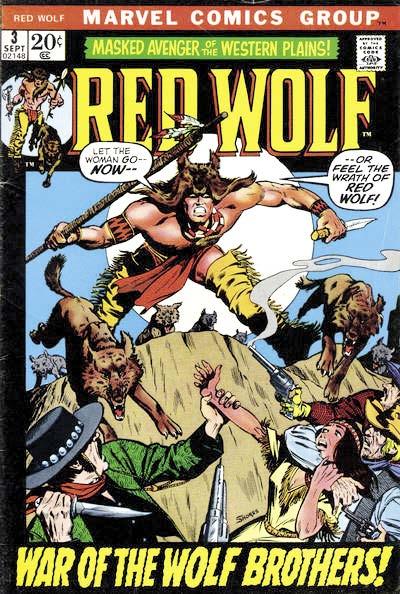
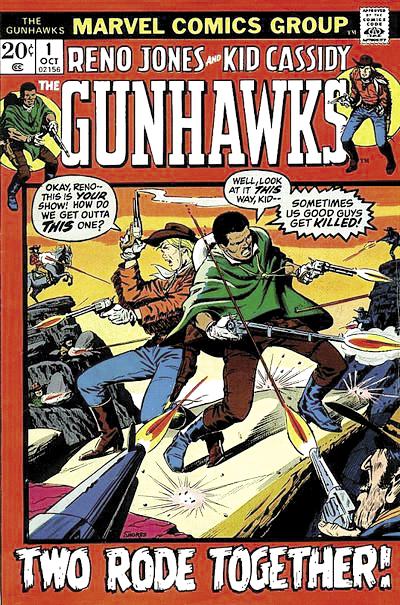
Go West, Marvel Man! Two of Shores’ late covers for Marvel were Westerns—Red Wolf #3 (Sept. 1972) and The Gunhawks #1 (Oct. 1972). Thanks to the GCD. [TM & © Marvel Characters, Inc.] RA: He kept that ability throughout his career because his artwork in the late 1960s and early 1970s, which I’m most familiar with, is just as good, whether doing full pencils and inks or just inking, as his 1940s and 1950s work.
KARLEBACH: I think so as well. He was an accomplished artist all though those years and continued to be so when comics fell out of favor and he moved into magazine illustration, and then again when he returned to comics in the 1960s. But... many of those 1930s-1970s artists weren’t and haven’t been recognized for their contributions because they weren’t in the business when comics really began to get positive recognition from other media. I think my Dad might well be regarded as a legend, just as some of the other Golden Age artists were recognized and received acclaim at San Diego and elsewhere for their early work, if he’d have lived longer.
RA: I think you’re correct. Unfortunately, he passed away just on the cusp of comics being recognized for the good they had within them, as well as the very beginning of the time that the original creators were receiving long overdue credit for their work. KARLEBACH: Yes, Dad passed away at a fairly young age, as well. Just 59 when he died in 1973.
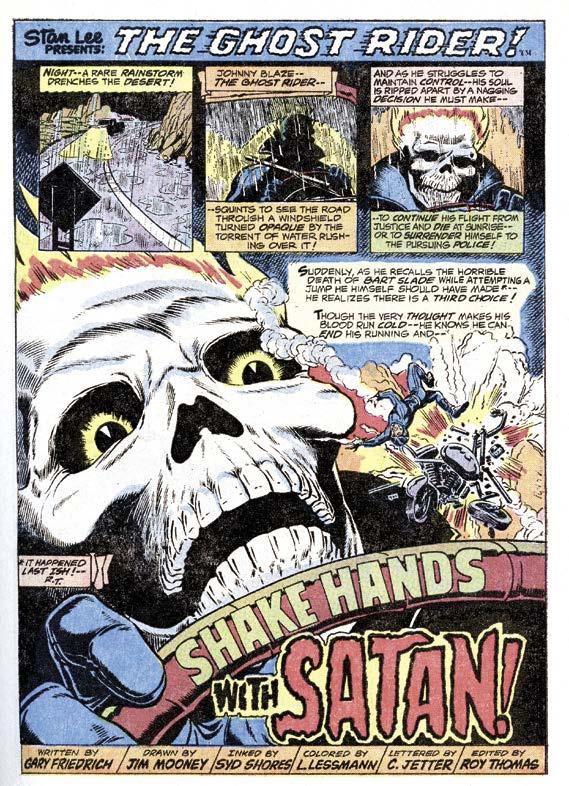

The Last Monsters Syd Shores was working away right up to the end! (Left:) He inked a Jim Mooney-penciled story for Ghost Rider #2 (Oct. 1973), with a script by Gary Friedrich—which led into the brand new “Son of Satan” series. (Right:) Splash of the “Frankenstein Monster” story from Monsters Unleashed #4 (Feb. 1974). Script by Gary Friedrich. Thanks to Barry Pearl for both scans. [TM & © Marvel Characters, Inc.]

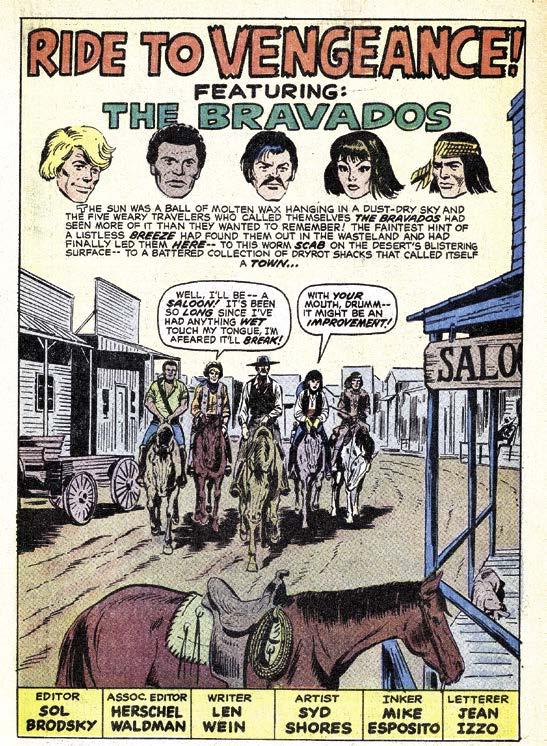
Bravado! Bravado! Bravo! Syd penciled the Skywald series “The Bravados” first in several issues of Wild Western Action, beginning with #1 (cover-dated March 1971), then in The Bravados #1-and-only (Aug. ’71)—with inking by Mike Esposito and scripts by Len Wein. Thanks to Nick Caputo and Douglas R. Kelly, respectively. [TM & © the respective trademark & copyright holders.] Around the same time, he drew the Black Rider sketch at right for a Street Enterprises Benefit Portfolio, printed by Flying Dutchman. Courtesy of Tom Hegeman. [Black Rider TM & © Marvel Characters, Inc.]
RA: I can remember the announcement of his death, both in the Marvel magazines and in some of the fan press, and it was a bit of a shock, because he’d been doing an enormous amount of work at the time, not only at Marvel but, as we mentioned, for Warren and Skywald as well. I remember that one of his last jobs, a “Frankenstein” story for Marvel’s Monsters Unleashed, was clearly finished by another artist, Win Mortimer. In fact, I think that Win redrew the Frankenstein Monster’s head on every page so the monster would look consistent throughout the story, even though some of the pages were clearly inked by your father and others were completely inked by Mortimer.
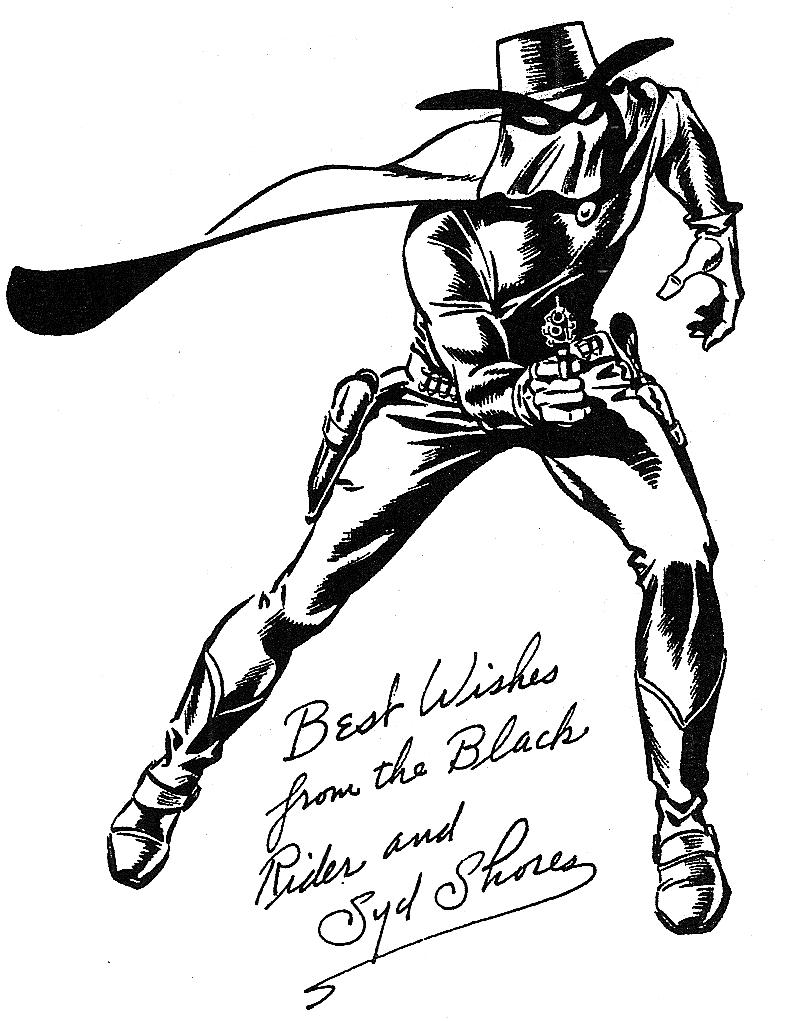
Was your father aware that he had a heart problem? Because I’m looking at his last credits, and it appears that he was busy right up until his dying day. He was doing that “Monster of Frankenstein” story, but he was also inking Ghost Rider #2. KARLEBACH: Yeah, he was busy. I don’t know if he knew that he was sick. It was really hard to get him to a doctor. He just didn’t go. And you have to remember that people in those days in general just didn’t know how important a regular check-up can be. He smoked a lot. Everybody did in those days, though. He was never really sick. Not sickly in any way. I don’t remember him ever really being sick. The day that he died, he’d gone with my mother shopping. Then he came home and had a heart attack. It was very sudden.


The Boy Who Cried “Red Wolf” Both incarnations of the Native American hero Red Wolf were penciled—and sometimes inked—by Syd Shores over the series’ 9-issue life: in issue #1 (May 1972), which postulated one or more heroic ancestors of the character who’d been introduced in The Avengers #80 (Sept. ’70)—and in #7 (May ’73), wherein the modern-day Red Wolf commandeered the title for the rest of the run. Respective scripts by Gary Friedrich and Gardner Fox (in both cases, with contributions from co-creator Roy Thomas); respective inks by Wally Wood and Jack Abel. Thanks to Barry Pearl for the scans. [TM & © Marvel Characters, Inc.]
KARLEBACH: I know that one of the creators of Superman was a friend of my fathers, but I’m not sure which one. It was the one who lived in Queens and was losing his eyesight. My dad often visited him in his later years. I just have a recollection of being there with my Dad.
RA: That would have been Joe Shuster. KARLEBACH: Artists who came to our home? Well, Allen Bellman came quite often. Al Hewetson, when my Dad and he were working on their projects. When I started going to some of the comic-cons, I met Gene Colan and Dick Ayers, along with their wives. I found out then that Dick Ayers had been to our house, although I didn’t remember it. Those would be the main ones that I’m aware of.
RA: One of the things we try to do when we’re dealing with people remembering writers and artists who’ve passed away is to get a sense of what that person was like. What would you like to say about your Dad in that regard? KARLEBACH: He was a wonderful father. I was very close to him. I think, in the industry itself, he was quite respected. In the end I don’t think he was always given the work he wanted to do. Yet, I think that everyone he worked with and for respected his talent and his work. he went back to comics. This would have been 1967 or so. He was given more inking assignments and not the full illustrations that he liked to do. Except for Red Wolf. Red Wolf he actually penciled and inked. That was what he liked. He liked to do the art his way, do the complete job. However, he was mostly inking. He was kept very busy doing that, though.
He worked for a long time at home and, because of that, he was always there to help out with a home or family crisis. His family enjoyed him. He was very well-loved. He was a worrier, in a way. He always had to make those deadlines!
He had a large collection, at one time, of the comics that he’d
Stamp Your Feet! The Kirby cover of Captain America #100 (April 1968), inked by Shores, became one of the Marvel U.S. commemorative stamps a few years back—when the price of a first-class letter was a mere 41¢. Hey, it wasn’t that long ago! [Art TM & © Marvel Characters, Inc.]
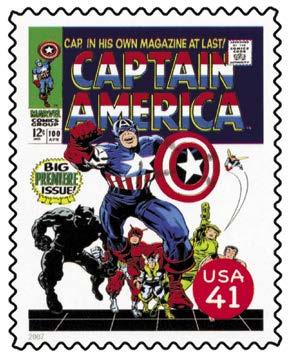

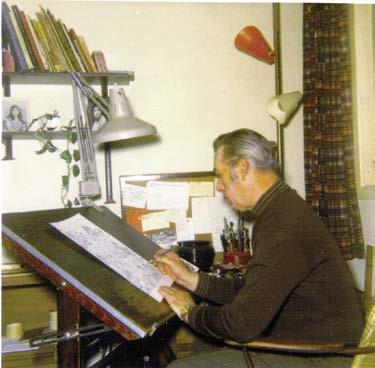

Back To The Drawing Board! Sitting at his board in later years, Syd Shores might well have been musing either on some of his most recent work—like his story “Ando!” for Warren’s Creepy #34 (Aug. 1970), scripted by Robert Rosen— or of his glory days as artist of the lead story in Captain America Comics #24 (April ’43), written by science-fiction pulpster Ray Cummings. Either way, Syd has left a legacy of comicbook greatness behind him—and ahead of us—for all time! Photo courtesy of Nancy Shores Karleback & Shaun Clancy. [Creepy page TM & © The New Comics Company; C.A. page TM & © Marvel Characters, Inc.]
drawn, but he threw them all away when we moved from Brooklyn to Long Island. Comics weren’t really valued in those days. He did live long enough to regret throwing them, though! [laughs] What has mostly survived is the work he did in the years just before his death.
One of the nice things that has happened fairly recently was that the Post Office put out a series of commemorative stamps featuring Marvel Comics covers, and one of them was a Jack Kirby/Syd Shores cover from Captain America. The Post Office didn’t used to provide information on artists who had their work used for stamps, but now they apparently do. On the back of the sheet they put the names of Jack Kirby and my Dad. That was very exciting. I didn’t know about that in advance. I just happened upon it. [laughs]
RA: Thank you for agreeing to do this interview. It’s been a real pleasure to speak with you. KARLEBACH: Oh, you’re so welcome!
Richard Arndt is a librarian from the wilds of Nevada. He reads a lot of comics.
SYD SHORES Checklist
[This checklist is adapted primarily from information provided in the online Who’s Who of American Comic Book 1928-1999, established by Dr. Jerry G. Bails and viewable at www.bailsprojects.com. Names of features that appeared both in magazines with that title and also in other publications are generally not italicized below. Key: (w) = writer; (p) = penciler; (i) = inker.] Name: Sydney Lawrence Shores (1918-1973) – artist. Primarily Captain Wonder (p)(i) 1943; Chamber of Chills (i) 1972-73; Chamber of known as “Syd,” his first name was occasionally spelled “Sid.” Darkness (i) 1970; Combat Kelly (p)(i) 1954; Commando Adventures (p) Pen Name: Jim Elder (i) 1957; Complete Mystery (p)(i) 1948; covers (p)(i) 1946-49, 1953-56, 1968-69, 1972-73; Creatures on the Loose (i) 1971; The Crusader (p)(i) Art Education: Pratt Institute 1955-56; Daredevil (p)(i) 1969-73; Dracula (i) 1973; Dracula Lives (p) Influences: Hal Foster, Alex Raymond (i) 1973; fillers (i) 1953, 1956; Frankenstein (p)(i) 1974; Ghost Rider (i) 1971-73; Hulk (i) 1968, 1976; Human Torch (p)(i) 1942, 1946-48; Print Media (Non-Comics): artist – magazines, pulps, Westerns, illustration (p)(i) 1947; Journey into Unknown Worlds (p)(i) 1956; various men’s-adventure magazines. Co-owner: Commercial Art Jungle Adventures of Greg Knight (p)(i) 1955; Kid Colt (p)(i) 1948, Studio. Partners: Mort Lawrence and Norman Steinberg 1952-55 1950; Kid Colt Outlaw (p)(i) 1956; Lo-Zar (p)(i) 1955; Major Liberty Syndication: The Satirists (p)(i) 1971, for Canada (publication uncomfirmed); Tales of the Macabre (daily & Sunday) c. 1972, unsold (p)(i) 1941; Man Comics (p)(i) 1949-51; Man-oo the Mighty (p)(i) 1955; Marines at War (p)(i) 1957; Marvel Tales (p)(i) 1957; Masked Raider (p)(i) 1940; Miss America (i) 1946-47; Mr. Wu (p) 1946; My Promotional Comics: advertising comics (p)(i) for Schneider/Allen Own Romance (p)(i) 1949; Mystery Tales (p)(i) 1956; Navy Action (p) and Wash, Inc. (i) 1956-57; Navy Combat (p)(i) 1958; Nick Fury (i) 1969; Rawhide Comics Studio/Shop: Harry “A” Chesler Shop (assistant) c. 1940 Kid (i) 1971; Rawhide Kid (p)(i) 1956; Red Hawkins (p)(i) 1950; Red Wolf (p) 1971-73; Rex Hart (p) 1950; Sailor Sweeney (p)(i) 1956-57; COMICBOOKS (U.S. Mainstream Publications): Sgt. Fury (i) 1971-72; Strange Tales (p)(i) 1952; Sun Girl (i) 1949; Avon Comics: Police Lineup (p)(i) 1952; science-fantasy (p)(i) 1952; Suspense (p)(i) 1956; Tales of Fort Rango (p)(i) 1970; The Terror (p) war (p)(i) 1952 (i) 1941; Two-Gun Kid (p)(i) 1948-49, 1955; Uncanny Tales (p)(i) 1957; DC Comics: Casebook Mystery (p)(i) 1952; Gang Busters (p)(i) 1950, Unknown Jungle (p)(i) 1955-57; The Vision (p)(i) 1942; War Comics (p)(i) 1952, 1954; Tales of the Watcher (i) 1968; Tales of the Watcher 1955 (p) 1969; Western Outlaws (p)(i) 1957; The Whizzer (p)(i) 1941; World Major Magazines: Cracked (p)(i) 1958-59; horror (p)(i) 1969-70; Web of Suspense (p)(i) 1956; Young Allies (p)(i) 1940s of Horror (w)(p)(i) 1969-70 Orbit Publications: covers (p)(i) 1951-52; crime (p)(i) 1950; romance Marvel/Timely Comics: All Winners Squad (p) 1946; The (p) 1950-53; Wanted Comics (p)(i) 1951-52; Wild Bill Pecos (p)(i) Avengers (i) 1969, 1972; backup feature (p)(i) 1954 in Combat Kelly; 1950-51 backup feature (p)(i) 1956 in Jann of the Jungle; backup feature (p) (i) in Kid Colt Outlaw 1956; backup feature (p)(i) in Sailor Sweeney; backup feature (p)(i) in Two-Gun Kid; Battle Action; Battle Brady (p)(i) 1952-54; Battle (p)(i) 1953, 1956-58; Battlefront (p)(i) 1954-55; Skywald Publishing Company: The Bravados (p) 1971; covers (p) 1971; mystery/occult (p)(i) 1970; Nightmare (p) 1970; Western (p) 1971; The Wild Bunch (p) 1971 Battleship Burke (p)(i) 1956; The Beast (p)(i) 1972; Black Fury (p)(i) Warren Publications: Creepy (p)(i) 1970-71; Eerie (p)(i) 1971; 1950; Black Knight (p) 1955; Black Panther (i) 1976; Black Rider (p)(i) horror (p)(i) 1969 1948-50, 1953-56; Blonde Phantom (p)(i) 1946-49; Captain America (credited as “art associate”) 1946; Captain America (p)(i) 1941-47, 1968-69; Captain Marvel (i) 1969; Captain Savage (i) 1968-69; Ziff-Davis Comics: (i) 1952 horror (p)(i) 1952; Nightmare (p)
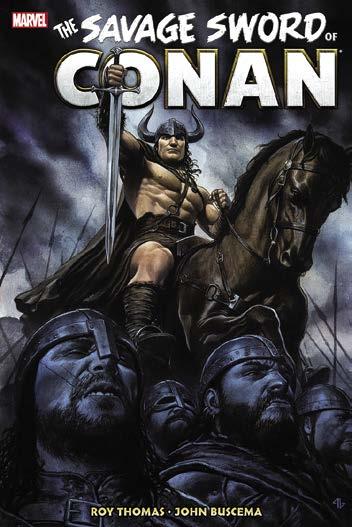

the savage sword of
CONAN IS UNSHEATHED—FOR THE 4TH TIME! Nearly 1000 Pulsating Pages! SAVAGE SWORD OF CONAN:
THE ORIGINAL MARVEL YEARS – VOL. 4! Re-presenting
SAVAGE SWORD OF CONAN #45-60 (1979-1981) by THOMAS • BUSCEMA • COLÓN • KANE • VOSBURG! Regular Edition Variant Edition (new Adi Granov cover): (Earl Norem cover) ISBN #978-1-302-92244-3 ISBN #978-1-302-92245-0 $125 U.S. ($158 Canadian)









